THREATS TO URBAN FORESTS

Photo by Craig Vodnik on Unsplash
"What are the hazards trees in cities face," a student asked me this summer. I gave a thoughtful but short answer along the lines of it depends on where the tree is located—sidewalk, park, natural area—and if the tree was planted with a carer lined up to provide stewardship. The NYC Parks Department segments the urban forest into three categories: street trees, trees in landscaped parks, trees in forested natural areas. While there are overlapping threats, trees growing in sidewalk settings face unique challenges.
There is a laundry list of threats to trees everywhere, and new ones seem to pop up constantly. With the news of Beech Leaf Disease (BLD) and the decline of the beech component in northeast forests—seeing the effects of BLD in real life—the wind was knocked out of me this summer. I began drafting this post in August and have been sitting with it since then.
 |
| American Beech canopy showing signs of Beech Leaf Disease |
This more comprehensive response to question about threats to urban trees is not the catharsis urban forest-lovers need, but writing about trees in any capacity is giving attention to trees which is sorely needed in our lives.
New York City categories the 861, 576 trees on its Tree Map into three populations:- forested natural areas
- landscaped parks
- sidewalks
The trees in the forested natural areas bucket are part of 7,300 acres of forest communities. Forested natural areas are structurally and functionally different than trees in landscaped parks and street trees which are managed under arboricultural standards or individually.
Trees in forested natural areas face several major threats including but not limited to fragmented habitat, invasive species, pest & disease pressures, climate change, and disturbed regeneration. The Natural Areas Conservancy details management strategies for forested parkland.
In a landscaped park setting where trees have been purposefully planted (trees are also hand planted in forested natural areas as part of restoration projects) and where the landscape is more intensively managed (think: mowing and weeding to control spontaneous vegetation and regeneration), the primary pressures on trees are adaptability to climate-disrupted temperature and moisture regimes, pest and disease impacts, incompatibility with lawn care, and soil compaction from human use and off-leash dog activity.
The suite of hazards for street trees include some of the pressures faced by trees in forested areas and in parks, plus challenges specific to the more public location of this population of urban trees. Keep reading for ten threats to street trees.
TEN THREATS TO STREET TREES
1. Lack of funding
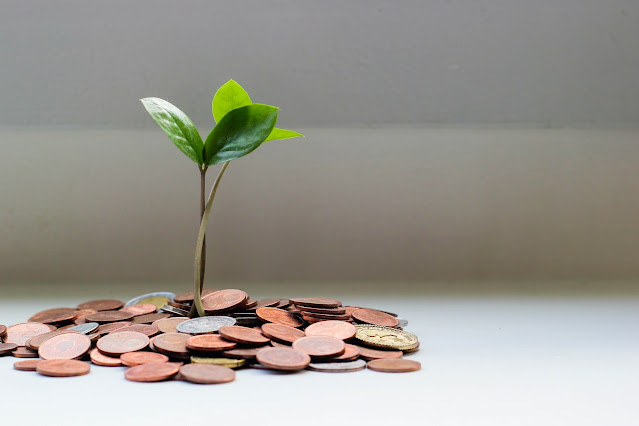 |
| Seedling growing out of a pile of coins (Photo by micheile henderson on Unsplash) |
One threat I did not include in my response to the student or in my first draft of this post was lack of funding. I am uncomfortable describing trees as infrastructure. Trees are living beings. Healthy lives require resources that need to be paid for. Backed by a broad coalition of advocates, two urban forestry laws in New York City were passed this fall—achieve 30% canopy cover equitable by 2035 and create an urban forest plan. I felt hopeful about trees in the city. However, the mayor's proposed 5% budget cuts to already deeply underfunded agencies like NYC Parks, which manages 14% of the city's land with only 0.6% of total city budget, has deflated me again.
2. Overhead infrastructure
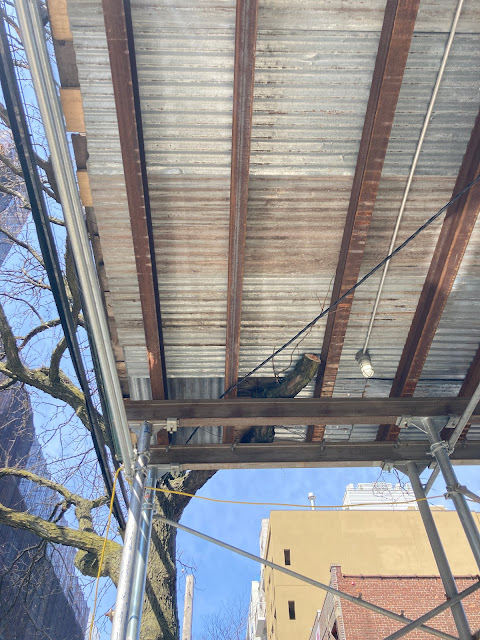 |
| Tree branch pruned to accommodate scaffolding |
In New York City, scaffolding is the number one overhead infrastructural threat to trees. Manhattan Borough President Mark Levine remarked in an interview with CBS News, "The average sidewalk shed is now staying up for over 400 days....There are some that have been up over 10 years, and even cases in which these eyesores have been out there for over 15 years." Some sidewalk shed installers make space for tree trunks, branches, and stems. Other installers are careless and trees are damaged during installation. In addition, scaffolding can prevent sunlight and rainfall from reaching the tree.
Power lines are another overhead nuisance for street trees. In communities where the electric grid is not underground, trees that attain heights of 25 feet or more become entangled with overhead wires. The presence of overhead wires can be a limiting factor in canopy height since either small statured trees are planted or tree crowns are reduced. It is still the case that utility pruners do not gracefully trim this subpopulation of street trees resulting in malformed silhouettes and aggressively reduced crowns.
3. Root Zone Conflicts
Underground infrastructure is less evident than overhead wires but they are no less consequential for street trees. Have you ever wondered what is 30 feet below a city sidewalk or street? Power, cable, water, steam, gas, and miscellany construction remnants and engineering artifacts. These objects impact if and where a tree can be planted in the sidewalk. Malfunction and repairs to these systems affect existing trees. I have watched several street trees die after exposure to leaky steam pipes.
4. Girdling
 |
| Tree trunk being girdled by 3 different items |
Do you know why there are rules against wrapping objects around tree trunks and branches? It’s to prevent girdling. To girdle a tree is to literally choke a tree’s access to water and nutrients. As your unattended string of lights tightens around a tree’s growing girth, the string cuts into the cells and tissues that transport sugars and water within the tree. The girdling object can also instigate bark damage which could provide an entry point for bacteria and pests.
Tape is also bad. Tape traps moisture between itself and the tree’s bark which can become a host site for bacteria and fungi.
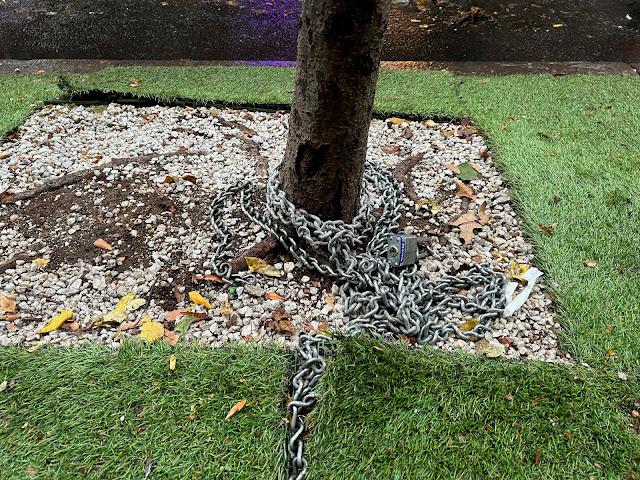 |
| Chain wrapped around the trunk flare of a street tree |
Don’t lock your bike, scooter, moped to a tree.
 |
| Electrical infrastructure attached to a tree's trunk |
Use the inanimate objects in the right-of-way to hang your lights, display your signs, secure your wheels.
5. People driving vehicles
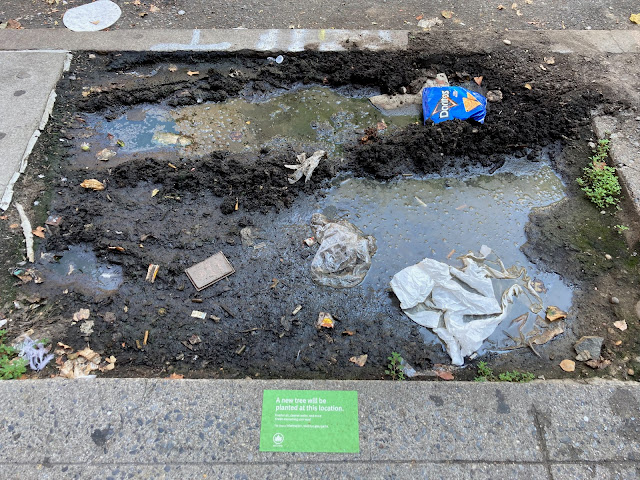 |
| Vehicle tire marks visible in wet soil/mud in a tree bed |
Coincidentally I finished reading Crossings: How Road Ecology is Shaping the Future of Our Planet by Ben Goldfarb as I was writing this post. People who drive have a lot of roadway at their disposal. There is no reason, but it happens, for people to drive or park their vehicles on the sidewalk. This behavior damages and kills trees. I have seen this happen; sometimes repeatedly in the same location.
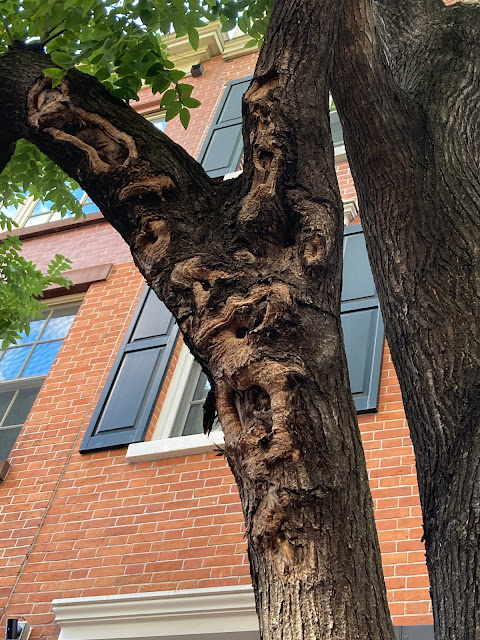 |
| Repeated injury to a tree's trunk from passing/parking vehicles |
Van and truck drivers damage the upper trunk and crown of trees while parking. I doubt a driver would scrape their vehicle against a light pole or restaurant awning in order to park their vehicle. We not treat trees as living beings. We don’t see them as something worth looking out for.
6. Not enough room to grow
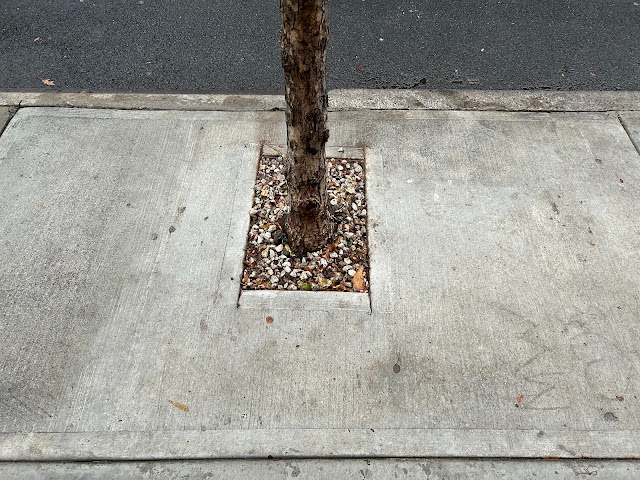 |
| Illegal concretization of a street tree bed |
A conventional metric of the amount of soil a tree needs is 1-2 cubic feet to 1 foot squared of crown spread. Do you remember outgrowing your shoes as a child? It was an uncomfortable to painful situation. Eventually you received a new pair of shoes.
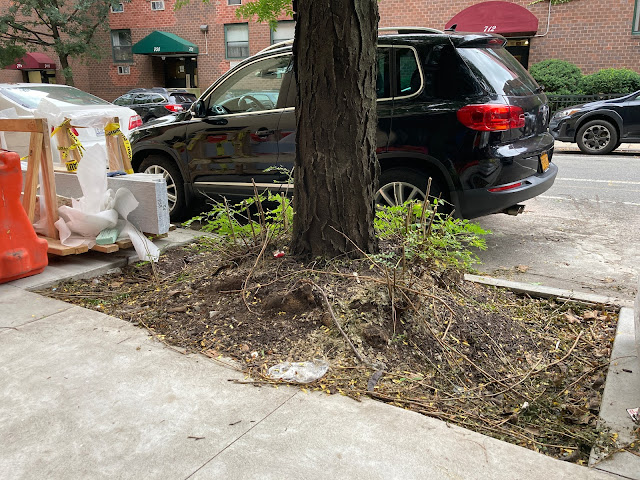 |
| This tree bed was expanded (the "mound" shows the original dimensions) |
A tree cannot get a new pair of shoes. Therefore, it is important to provide the greatest amount of soil volume possible at the time of tree planting. For example, if you envision your tree reaching 16 inches in diameter with a 32 foot crown spread, your tree requires 1,000 cubic feet of soil, says Deep Root.
7. Don't tread on tree beds
Compaction can reduce the soil volume available to a tree. The permeability of soil, the pore spaces between soil particle, is important for water and gas exchange in the root zone. When we walk within the tree bed or routinely place heavy bags of trash on the soil, the pore spaces in the soil get smaller and flatten thus compromising the drainage capacity of the soil and the ability of roots to navigate through the soil.
Two related issues are too much mulch and too much soil! Mulch has great properties. It protects the soil: reducing water loss and moderating soil temperature. Mulch can also help to reduce the impacts of compacting activities. Too much mulch can be a bad thing especially when mulch is applied close to the tree’s trunk which can become a breeding ground for fungi and bacteria.
Follow the advice in Mulch Out, Not Up.
Similarly too much soil is not a good thing for trees. A tree’s feeder roots are close to the surface of the soil. If you add soil, you can suffocate these roots. If you remove soil, you expose the roots and create the potential for physical damage and dehydration.
Related - Impact of Soil Mounding in Washington Square Park Woodland
Related - Did Too Much Soil Kill an American Linden in Washington Square Park?
8. Whose tree?
 |
| Two people engaged in soil care in a tree bed |
The absence of a steward can reduce the longevity of a tree. Most tree planting contracts include two years of post-planting care. In a contract this typically means seasonal watering and replacing dead trees. Contract maintenance is not equivalent to stewardship.
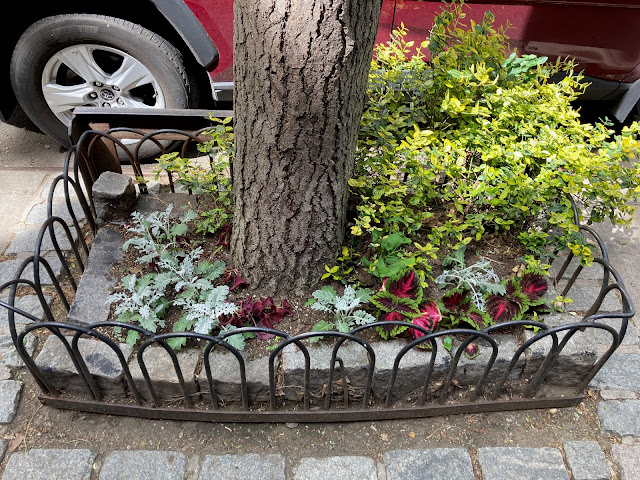 |
| A garden planted beneath a street tree |
“Trees are more successful when they are stewarded,” I wrote in a blog post titled People-Plant Relationships. Anecdotal evidence and research studies have proven this statement. In “People-Plant Relationships,” I cited five studies that showed higher survival rates in urban trees populations are correlated with human stewardship. The caring does not have to be hands-on either. Boyce (2010) found that “observational stewardship” where people watch out for trees and report threats which were quickly resolved reduced mortality rates in street trees. Jane Jacobs’ “eyes on the street” is applicable to more than just human safety.
9. Cues not to care
 |
| A tree bed lined with pink boards filled with trash |
Street trees have better survival rates when they are cared for by people. In their 2010 paper “Biological, social, and urban design factors affecting young street tree mortality in New York City,” Lu at al. found that tree carers leave signs of their stewardship such as underplantings, mulching, and signage. These “cues to care” are strong predictors of street tree survival.
I think cues not to care about street trees include trash, debris, and pet feces. All are environmental pollutants. However, Lu et al. (2010) found a surprise about animal waste in their research: “the presence of scat was unexpectedly associated with higher survival.” I am shocked. Pet waste is dangerous to human and watershed health. I have shoveled out pet waste from tree beds. It was an unpleasant task.
The NYC Department of Sanitation has a litter and pet waste clean up campaigns but they do not explicitly focus on tree beds. The tag lines are: “If you are litter, you are garbage” and “Don’t leave _ _ it on the sidewalk.”
10. Vandalism
 |
| This Ailanthus altissima was spray painted (c/o @collandthecity) |

Comments
Post a Comment
Thank you for commenting on this post!